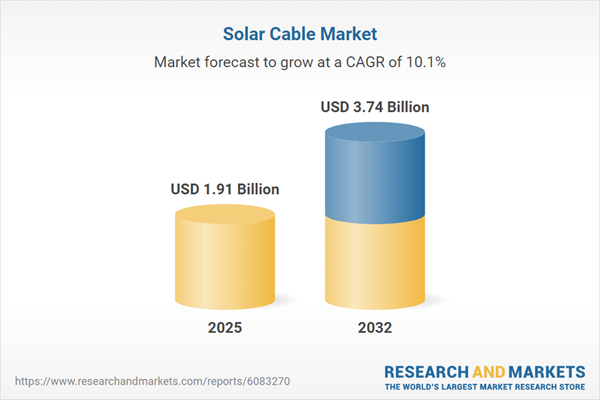Speak directly to the analyst to clarify any post sales queries you may have.
The solar cable market is transforming rapidly as demand for renewable energy accelerates and compliance frameworks evolve. Senior decision-makers require targeted intelligence on emerging technologies, global supply strategies, and regulatory trends to navigate complexity and secure robust market positions.
Market Snapshot: Solar Cable Market Growth and Trends
The solar cable market is advancing at a steady pace, expanding from USD 1.73 billion in 2024 to USD 1.91 billion in 2025, with projections indicating a rise to USD 3.74 billion by 2032 at a CAGR of 10.10%. This upward trajectory underscores global momentum in energy transition and investment in resilient cable technology. Organizations are embracing innovative conductor materials, including aluminum and copper, alongside advanced insulation systems such as LSZH, PVC, and XLPE. Suppliers and stakeholders are adjusting to region-specific regulatory requirements, prompting ongoing optimization across supply chains and product development. Enhanced infrastructure and value chain innovation are actively shaping market evolution.
Scope & Segmentation
- End User Profiles: Commercial projects include both ground-mounted and rooftop solar systems. Residential markets are focused on grid-connected and off-grid installations. Utility-scale operations encompass floating as well as ground-mounted deployments, reflecting the diversification of solar applications worldwide.
- Cable Types: Collector, inverter, and PV cables are offered in aluminum and copper configurations, catering to various photovoltaic installation scenarios and electrical needs.
- Conductor Materials: Aluminum conductors (bare or tinned) and copper conductors (bare or tinned) each present unique profiles in terms of cost efficiency, conductivity, and durability for different operational environments.
- Insulation Materials: LSZH, PVC, and XLPE insulations meet critical requirements for fire safety, environmental standards, and durability, supporting diverse project missions.
- Voltage Ratings: Low-voltage and medium-voltage cables allow for safe and efficient operation across residential, commercial, and utility-scale solar infrastructure.
- Installation Types: Overhead and underground options provide deployment flexibility, accommodating specific site conditions, safety protocols, and regulatory mandates.
- Region Coverage: Includes Americas (United States, Canada, Mexico, Brazil, Argentina, Chile, Colombia, Peru), Europe, Middle East and Africa (United Kingdom, Germany, France, Russia, Italy, Spain, Netherlands, Sweden, Poland, Switzerland, United Arab Emirates, Saudi Arabia, Qatar, Turkey, Israel, South Africa, Nigeria, Egypt, Kenya), and Asia-Pacific (China, India, Japan, Australia, South Korea, Indonesia, Thailand, Malaysia, Singapore, Taiwan).
- Company Profiles: Profiles encompass Prysmian S.p.A., Nexans S.A., Sumitomo Electric Industries, Ltd., LS Cable & System Ltd., Southwire Company LLC, NKT A/S, Leoni AG, Polycab India Limited, KEI Industries Limited, and Havells India Limited, each contributing specialized expertise and product diversity.
Key Takeaways: Strategic Insights for Decision-Makers
- Effective alignment between manufacturers, developers, and policymakers is increasingly critical for meeting new compliance standards and advancing performance criteria across markets.
- Uptake of digital monitoring and environmentally friendly insulation solutions is supporting operational efficiency and reducing future maintenance risks for solar infrastructure assets.
- Buyers are prioritizing versatile, high-performance cables that reinforce flexible solar deployment models, microgrid integration, and seamless interfacing with energy storage or EV charging systems.
- Building supply chain resilience and expanding sourcing networks—both regionally and globally—protects businesses against volatility and supports continuous project delivery.
- Advanced research, vertical integration, and multi-sector partnerships continue to generate sustainable advantages and operational optimization for market leaders.
- Strategic approaches vary across regions: incentives support adoption in the Americas, standards harmonization drives efficiency in EMEA, and Asia-Pacific pursues deployment methods synced with rapid rooftop solar proliferation.
Assessing Tariff Impact: Policy Shifts and Supply Chain Responses
Recent updates to United States tariffs in 2025 have prompted solar cable market participants to reassess procurement and production strategies. Organizations are countering rising costs through long-term domestic partnerships and by evaluating alternative import practices. This environment is fostering greater manufacturing agility, with adaptive sourcing initiatives designed to balance tariff risks. Companies are increasing investment in alternative conductor alloys, expanding talent pools within emerging manufacturing hubs, and pursuing joint ventures aimed at supply chain stability. Ongoing scenario planning and active regulatory engagement are essential to ensure resilience and responsiveness throughout the value chain.
Methodology & Data Sources
Insights are grounded in multi-source research, incorporating executive interviews, direct feedback from project developers, and analysis of technical standards and patent records. The data is validated with repeated expert panel reviews, ensuring reliability and adherence to ethical research standards through a triangulated approach.
Why This Report Matters
- Actionable market data enables organizations to make informed supply and investment choices within dynamic solar cable markets.
- Leaders can strategically position their business by understanding the intersection of innovation, regulatory developments, and supply chain planning.
- Extensive segmentation and regional breakdowns inform targeted research, partnership selection, and entry strategies for sustained expansion.
Conclusion
Organizations that prioritize adaptive strategies and foster innovation are better equipped to build resilient growth in the evolving solar cable sector. Embracing regulatory adaptability and technological progress will drive long-term value in a competitive energy marketplace.
Table of Contents
3. Executive Summary
4. Market Overview
7. Cumulative Impact of Artificial Intelligence 2025
Companies Mentioned
The companies profiled in this Solar Cable market report include:- Prysmian S.p.A.
- Nexans S.A.
- Sumitomo Electric Industries, Ltd.
- LS Cable & System Ltd.
- Southwire Company, LLC
- NKT A/S
- Leoni AG
- Polycab India Limited
- KEI Industries Limited
- Havells India Limited
Table Information
| Report Attribute | Details |
|---|---|
| No. of Pages | 182 |
| Published | October 2025 |
| Forecast Period | 2025 - 2032 |
| Estimated Market Value ( USD | $ 1.91 Billion |
| Forecasted Market Value ( USD | $ 3.74 Billion |
| Compound Annual Growth Rate | 10.1% |
| Regions Covered | Global |
| No. of Companies Mentioned | 11 |









